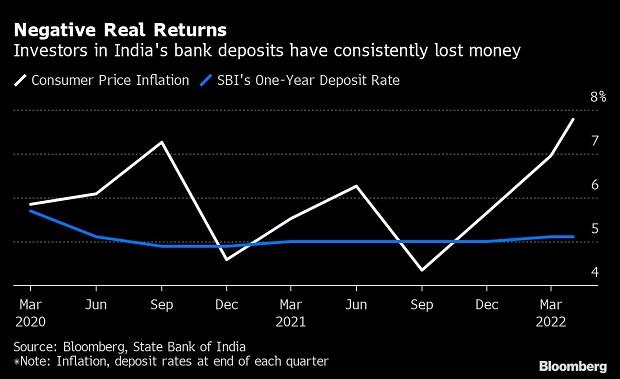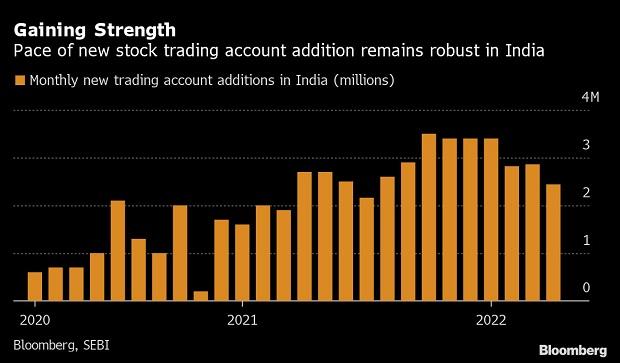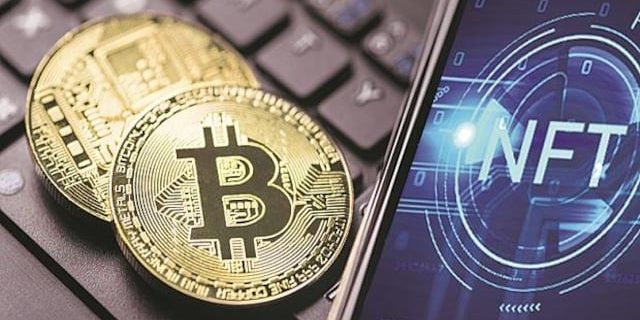An impatient Indian investor class, largely driven by millennials, is leaping into riskier investments from peer-to-peer lending to cryptocurrencies in the hope of boosting returns rocked by one of the worst inflation rates in Asia.
The sheer number of individuals pouring money into new and lightly controlled assets sets India apart, after the pandemic fueled the rise of retail investors globally and left many exposed to the potential for large losses. Others have been luckier and wracked up wins while racing to buy a first car or apartment.
In Mumbai, Pratik Vora, 28, who works in finance, is shunning the plain vanilla saving deposits that were popular with Indians for generations. Instead, he's investing in equities and cryptocurrencies. A self-taught investor, Vora started with stocks in 2015 and ventured into crypto investing in 2019 to buy a bigger house. He only narrowly escaped the giant plunge in cryptocurrencies this year after earlier withdrawing from them to avoid new taxes in India, yet he remains undeterred.

“At this point in time, a bank fixed deposit is the worst investment for any individual because inflation adjusted returns are negative,” Vora said. “I had a few setbacks too, lost money, but those were my learnings. My age allows me to take risk.”
Regulators everywhere are grappling with those risks, but the absolute scale of the shift in India is creating unique new regulatory complexities for Prime Minister Narendra Modi's government. Long a nation where households squirreled away their savings in the bank, about 43 million equity accounts have been added in India since the beginning of 2021, more than the total populations of Belgium, Greece and Portugal put together.
As inflation has pushed past 6%, bank deposits have steadily become less attractive because the real return on fixed deposits turned negative. Consumer price increases have shot up to the highest levels in decades in many countries around the world, with a reading last week in the US that notched a 40-year high adding to a slate of troubling data.
The renewed sense that central banks will have to do more to fight inflation is also making financial markets more volatile, as underscored by a renewed selloff across asset classes from late last week.

Many young Indians who want the chance at bigger returns are nonetheless venturing into even more volatile territory.
Ekmmeet Singh, the chief executive officer of peer-to-peer lending platform Lendbox, estimates that Indians are making about $3 billion in annual investments across new-age alternative investment platforms. They separately had $6 billion invested in crypto assets, a member on a parliamentary panel said last year.
Retail investors have also been drawn in by the ease of investing created by the dozens of fintech startups that have sprung up, enabling investments within minutes over mobile phones or digital platforms.
India's new fintech firms promise high returns on products that often carry greater risks. Jiraaf, an alternative asset platform, is marketing investment products tied to invoice discounting that can yield 9%-14% for 30-90 days and corporate debt with 1-3 year tenors that yield 8%-20%, according to its website. Grip says investors could make up to 21% pretax returns in leases. BondsIndia.com is advertising returns of 275% over what fixed deposits bring in.
But with the Reserve Bank of India raising rates and tightening cash to quell inflation, there's a rising risk that the assets underlying these products could come under stress.
Jiraaf and the other companies say they work hard to protect investors. Lendbox said it uses data and other mechanisms to ensure the quality of its borrowers is of the highest order and to work towards the recovery of unpaid loans. Grip, the asset leasing firm, says it does rigorous due diligence on all deals and uses measures like security deposits to protect clients.
“Indians have limited investment opportunities,” said Saurav Ghosh, co-founder at Jiraaf. “We wanted to bring high-yield fixed-income products that cater to the gap between equities and bank fixed deposits.”
Asset Leasing
In Mumbai, Anirudha Basak, 27, who works at a Mumbai-based fintech-platform, says he and his family have seen payoff from alternative investments. After a casual conversation with a product manager at another platform called Leaf, Basak invested about 500,000 rupees ($6,404) in asset-leasing on behalf of his mother, who he says is now receiving monthly interest payments.
But the big elephant in the room remains crypto, with exchanges reporting massive jumps in user base in smaller cities. The central bank has pushed back against the asset, citing financial stability concerns, but the government is yet to decide on its legal status.
Crypto markets have slumped recently as stagflation concerns drag on risk assets, with Bitcoin dropping to the lowest level since December 2020 and other major tokens like Ether also falling sharply Monday.
The Reserve Bank of India has set up a department to oversee fintech and is regulating non-banking financial entities like peer-to-peer platforms. The capital markets regulator, the Securities and Exchange Board of India, is also planning to look into corporate bond platforms.
“Traditional asset classes like equity, fixed income, real estate, etc., are well covered under the regulatory framework with adequate investor protection built into their respective governing regulations,” said Srikanth Subramanian, CEO-designate at Kotak Cherry, an investment platform providing an array of products to retail investors. “However, in case of emerging asset classes like crypto that are yet to come under the gamut of a dedicated securities regulator, the lacuna still exists that needs to be plugged by regulation.”
In recent years, the risks of alternative platforms with limited regulatory oversight have been on show elsewhere in the world. China saw a wave of defaults on peer-to-peer lending platforms in 2018, fueling a regulatory crackdown.
It can be hard for new investors anywhere to keep up. As a software engineer in New Delhi, Gagandeep Singh said he made a string of investments over the last few years that cost him money, and he lent on one peer-to-peer platform that left him with losses when some borrowers stopped paying him back.
Now working for an information technology company in Canada, Singh, 37, focuses mostly on passive index funds, but isn't completely shying away from risk. “I do keep 5-10% for risky bets,” he said. “That's the money I play with. That gives me the thrill.”
Singh's latest obsession is cryptocurrencies, where he invested almost $10,000 at the peak though the value of that has dropped. “I might lose money,” he said. “It might go to zero – or it might make me rich.”
Others are taking a similar approach. The head of marketing at a Mumbai education technology firm, Sunny Amlani, 38, has been stuck with a loss of 17% on his crypto investments. A tax regime that doesn't make it possible to offset losses in crypto with any other income makes exiting digital currencies difficult.
Yet, he isn't fully giving up on cryto, he said. “I think it's a good time to stick around and am definitely going to hold on for a while to see where it goes.”






